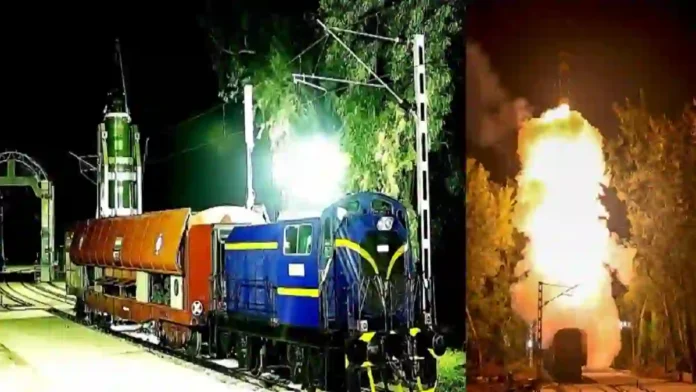India recently conducted a historic test launch of its nuclear-capable intermediate-range ballistic missile, Agni-Prime, from a rail-based mobile launcher system. This launch marks a significant milestone, placing India among a select group of nations—the United States, Russia, and China—that have demonstrated the capability to launch ballistic missiles from trains.
With a striking range of up to 2,000 km, Agni-Prime was fired from a specially designed railcar pulled by an Indian Railways locomotive, showcasing India’s strategic deterrence advancements and mobility in missile deployment.
Read- What Key Role Will Sukhoi Su-57 Stealth Fighter Play For The Indian Air Force?
The rail-based launch system offers several advantages over traditional silo or road-based launch platforms. By integrating missile launchers on the extensive Indian Railways network—one of the largest globally with nearly 70,000 km of tracks—the military gains unprecedented flexibility to disperse and conceal missiles across remote locations without road support.
Concealing missiles inside train tunnels helps evade satellite detection until launch, greatly enhancing survivability and surprise capability in the event of a conflict. The mobile nature of the launcher allows rapid reactions and reduces vulnerability to pre-emptive strikes on fixed missile bases.
Rail-based missile launch technology dates back to the Cold War era. The Soviet Union pioneered this with the RT-23 Molodets, a solid-fuel ICBM launched from special trains capable of carrying nuclear warheads, which served as a mobile nuclear deterrent across its vast territory.
The United States also developed a similar platform called the Peacekeeper Rail Garrison during the 1980s to maintain strategic strike capability in case of a nuclear first strike against silo-based systems. However, US rail-based missile programs were cancelled post-Cold War.
Russia considered reviving the system with the Barguzin BZhRK project but shelved it to prioritize hypersonic missile development. India’s success aligns with these historical precedents and marks a modern capability combining mobility, concealment, and rapid deployment.
Read- India’s Aircraft Carrier Plan Hit by US Tech Delays: US Betraying Indian Navy?
Read- L&T Forms Strategic Partnership With BEL For India’s AMCA 5th-Generation Fighter Aircraft Program
The strategic implications of rail-launched missiles like India’s Agni-Prime for regional security are significant and multifaceted:
Enhanced Survivability And Deterrence: Rail-launch capability drastically increases the survivability of India’s missile arsenal by dispersing launch platforms across the vast railway network, making it difficult for adversaries to locate and target missile sites. Mobility enables concealment in tunnels or blending with civilian rail traffic, thus reducing vulnerability to pre-emptive strikes. This enhances the credibility and effectiveness of deterrence by ensuring a retaliatory second-strike capability, vital in a nuclear-armed regional environment including Pakistan and China.
Increased Operational Flexibility And Rapid Response: Missile launchers on movable rail platforms offer the Indian military quicker reaction times and flexibility to launch from multiple, often unexpected locations across diverse terrain—from mountains to coastlines. This adaptability complicates enemy targeting strategies and enhances India’s capacity to respond swiftly to emerging threats, thus maintaining strategic stability in a volatile regional security context.
Complicating Adversary Calculus: By introducing unpredictability in missile deployment and launch readiness, rail-based launchers degrade adversaries’ ability to conduct effective first strikes or neutralize India’s strike capacity. The mobility and concealed deployment force neighbouring countries to allocate significant resources to surveillance and countermeasures across a widespread area, thereby complicating their strategic planning and raising the stakes of regional military engagement.
Strengthening the Nuclear Triad And Strategic Balance: Rail-based missiles complement India’s nuclear triad by adding another survivable and mobile launch platform besides land, air, and sea systems. This contributes to regional strategic stability by reinforcing credible minimum deterrence and balancing missile developments by rivals. It aligns with India’s posture of defensive deterrence aimed at preventing conflict escalation in South Asia’s complex security environment.
Potential Vulnerabilities And Challenges: While rail-launch systems improve mobility, they remain limited to areas with railway access and depend on the security of rail infrastructure, which could be vulnerable to sabotage. Despite some trade-offs in launch precision, the overall strategic benefits outweigh these limitations in bolstering deterrence and survivability.
While rail-based launchers provide strategic mobility and concealment, there are inherent limitations. The missile launch is restricted to locations along existing railway lines, and extensive security is required to protect the rail infrastructure from sabotage during wartime.
Moreover, rail-based launchers might have less precise launch parameters compared to fixed or specially designed missile silos, potentially impacting targeting accuracy. Nonetheless, the strategic benefits in dispersal and survivability are regarded as outweighing these challenges, strengthening India’s nuclear deterrent posture.
The successful rail-based launch of the Agni-Prime missile demonstrates India’s advanced missile deployment flexibility, survivability, and strategic depth. By joining an elite list of countries with this capability, India significantly enhances its nuclear deterrence and rapid response options, leveraging its vast railway infrastructure to protect and operationalize its missile arsenal effectively.
IDN (With Inputs From Agencies)
Agencies




